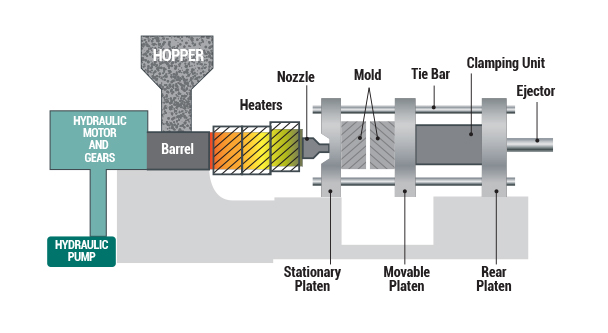In a broad sense, "automotive mold" is a general term for the molds that make all the parts on a car. For example, injection molds, stamping dies, forging dies, casting wax dies, glass dies, and the like. When people talk about cars, the first thing that comes to mind is the body of the car. That is to say, the body is the identity assembly of the car. The body represents the image of the car. In the narrow sense, automotive molds are the general term for the molds that punch all the stampings on the car body. That is, "automobile body stamping die". For example, a top cover flange mold, a beam reinforcement plate press mold, and the like.
First, automotive plastic mold classification
There are many methods for classifying automotive plastic molds. According to the different methods of plastic parts molding, they can be divided into the following categories:
The injection mold is also called an injection mold. The molding process of such a mold is characterized in that the plastic raw material is placed in a heating cylinder of the injection machine. The plastic is heated and melted, and is driven by the screw or plunger of the injection machine to enter the mold cavity through the pouring system of the nozzle and the mold. The plastic is molded in the mold cavity by heat preservation, pressure keeping, cooling and solidification. Since the heating and pressurizing device can function in stages, injection molding can not only form plastic parts with complicated shapes, but also has high production efficiency and good quality. Therefore, injection molding accounts for a large proportion in the molding of plastic parts, and the injection mold accounts for more than half of the plastic molding mold. The injection machine is mainly used for the molding of thermoplastics, and has been gradually used for the molding of thermosetting plastics in recent years.
·Compression mode
The compression mold is also called a compression mold or a compression mold. The molding process of the mold is characterized in that the plastic raw material is directly added into the open mold cavity, and then the mold is closed. After the plastic is molten under the action of heat and pressure, the cavity is filled with a certain pressure. At this point, the molecular structure of the plastic produces a chemical cross-linking reaction that gradually hardens and sets. Compression molds are mostly used for thermosetting plastics, and their molded parts are mostly used for housings and daily necessities of electrical switches.
·Transfer mode
Transfer molds are also called injection molds or extrusion molds. The molding process of the mold is characterized in that the plastic raw material is added into the preheating charging chamber, and then the pressure is applied to the plastic raw material in the feeding chamber by the pressing column. The plastic is melted under high temperature and high pressure and enters the cavity through the casting system of the mold, and then Chemical cross-linking occurs and gradually solidifies. The transfer molding process is mostly used for thermosetting plastics, and it can form plastic parts with more complicated shapes.
·Extrusion die
The extrusion die is also called the extruder head. The mold can continuously produce plastics with the same cross-sectional shape, such as plastic pipes, rods, sheets, and the like. The apparatus for heating and pressurizing the extruder is the same as that of the injection machine. The molten plastic passes through the machine head to form a continuous molded part, which is particularly efficient.
In addition to the types of plastic molds listed above, there are vacuum forming dies, compressed air dies, blow molding dies, low foaming plastic dies, and the like. [Metal processing WeChat content is good, worthy of attention!
Stampings on automotive bodies are broadly divided into cover members, beam members, and general stampings. A stamping that can clearly represent the characteristics of a car is a car cover. Therefore, the more specific automobile mold can be said to be "automotive cover stamping die". Referred to as the car cover die. For example, the front door outer panel trimming die, the front door inner panel punching die, and the like.
Second, automotive stamping die classification
Of course, there are not only stampings on the car body. The molds for all stampings on the car are called “automotive stamping dies”. To sum it up is:
1. Automotive molds are the general term for molds that make all the parts on a car.
2. The automobile stamping die is a mold for punching all the stamping parts on the car.
3. The automobile body stamping die is a die that punches all the stamping parts on the car body.
4. Auto Cover Stamping Die is a mold that punches all the covers on the car body.
Automotive tire molds are used to vulcanize molds for all types of tires.
Third, car tire mold classification
1. Active mold consists of a pattern ring, a mold sleeve, and upper and lower side plates. Active mold distinguishes conical surface guided active mold and inclined plane guided active mold
2. The two halves of the mold consist of the upper mold and the lower mold.
Fourth, automotive mold high-speed cutting technology
High-speed machining technology has been widely used in the automotive mold manufacturing industry at home and abroad, and has achieved great benefits, but the mechanism and related theory of high-speed machining is still not perfect, and the high-speed cutting database for automotive molds has not yet been established. Domestic and foreign companies still choose the high-speed cutting tool parameters and high-speed cutting parameters. The traditional "trial cutting method" and "experience method" are still used. When processing a new type of material, it is often necessary to use a variety of tools for repeated cutting tests. Research and analysis of tool wear and damage methods and their causes, to find a set of the best tool materials and processing parameters, so repeated, blind, and waste a lot of manpower, financial resources and resources. For high-speed machining of special materials such as alloy cast iron, high-strength alloy steel, super alloy (such as titanium alloy), how to choose the right cutting tool according to the material characteristics, how to design reasonable cutting parameters, is still researching and developing. in.
High-speed machining technology is an advanced manufacturing technology in the 21st century, with strong vitality and broad application prospects. A series of problems that have been plagued by conventional machining of automotive molds can be solved by high-speed machining technology. In recent years, high-speed machining technology in the industrialized countries of the United States, Germany, Japan, etc. has been widely used in most mold companies, and about 85% of the mold EDM process has been replaced by high-speed machining. High-speed machining technology combines high efficiency, high quality and low consumption, and has become the mainstream in the international mold manufacturing process.
Through the practical application of high-speed machining technology in the automotive mold manufacturing industry at home and abroad, high-speed machining technology has the following advantages:
1. High-speed cutting processing increases processing speed
High-speed machining performs high-speed machining of automotive molds at a cutting speed of about 10 times higher than conventional cutting. Since the excitation frequency of the high-speed machine tool spindle far exceeds the natural frequency range of the “machine tool-tool-workpiece” system, the automotive mold processing process is smooth and without impact.
2. High-speed cutting processing production efficiency
Machining the mold with a high-speed machining center or a high-speed milling machine can complete the roughing and finishing of the profile and the machining of other parts of the automobile mold in one-time clamping of the workpiece, the so-called "One Pass Machining". The application of high-speed machining technology has greatly improved the development speed of automotive molds.
3. High-speed machining for high-quality machined surfaces
Thanks to the extremely small step and depth of cut, high-speed machining results in a high surface quality and even eliminates the need for a trimmer. [Metal processing WeChat content is good, worthy of attention!
4. Simplify the processing
Conventional milling can only be carried out before quenching, and the deformation caused by quenching must be manually finished or electroformed to form. Now it can be done by high-speed machining without surface hardening caused by electrical machining. In addition, due to the reduced amount of cutting, high-speed machining can use smaller diameter tools to machine smaller fillet radii and mold details, saving some machining or manual finishing, thus shortening the production cycle.
5. High-speed cutting makes the car mold repair process more convenient
In the process of using the automobile mold, it is often necessary to repair it several times to prolong the service life. If high-speed machining is used, the work can be completed faster, the machining effect of the milling machine can be obtained, and the original NC program can be used without reprogramming. And can be accurate.
6. High-speed machining can process hard car molds with complex shapes
According to the high-speed cutting mechanism, the cutting force is greatly reduced during high-speed cutting, and the cutting process becomes easier. The high-speed cutting process has great advantages in cutting high-strength and high-hardness materials, and can be processed with complex profiles and high hardness. Car molds.


